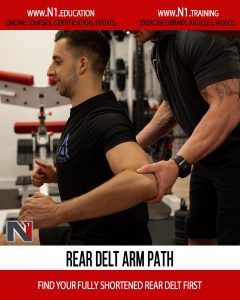Rear Delt Arm Path
n1 training
Before you perform a rear delt row or pullover (notice I didn’t mention a rear delt fly?), you need to find your fully shortened delt position so that you know what your arm path should be.
– – –
Finding your individual position is fairly simple. It will be the position where you can extend your upper arm back behind you the furthest without your shoulders rolling forward.
– – –
HINT: It will not be straight out perpendicular to your torso (also the reason why rear delt flys are not a good choice for fully shortening the rear delts)
– – –
For most people it will be around 45 degrees of adduction. The easy way to find the position is to push your elbows back as far as you can and slowly move your arms up and down until you find the spot where your elbows will go back the furthest. Again, without letting your shoulders roll forward.
Rear Delt Arm Path

Finding your individual position is fairly simple. It will be the position where you can extend your upper arm back behind you the furthest without your shoulders rolling forward.
HINT: It will not be straight out perpendicular to your torso (also the reason why rear delt flys are not a good choice for fully shortening the rear delts)
For most people it will be around 45 degrees of adduction. The easy way to find the position is to push your elbows back as far as you can and slowly move your arms up and down until you find the spot where your elbows will go back the furthest. Again, without letting your shoulders roll forward.

Popular Pages
Learn & Train With Us

Please log in to access the menu.